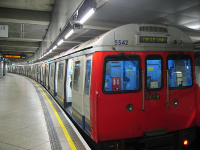“The Tube” is London’s underground rail network, a highly efficient mode of travel to and from a large part of Greater London and some parts of Buckinghamshire, Hertfordshire and Essex. The Tube plays an important role in the life of anyone visiting or living in London. Here is our simple guide to travelling on the tube.
• The network consists of 12 different railway lines, and you will find a poster of a Journey Planner at each station. This will tell you which line you need to take for any particular station. It’s also a good idea to get a smaller version of the planner that you can keep with you while you travel. These are available at any station or newspaper agent.• Except for the 25th of December, the Tube runs every day, beginning at 5:30 am. Rush hours are before and after work, that is before 9 am and after 4 pm. Try to avoid travelling at these times if you can, to keep away from crowds.
• The London Travel card or Oyster card is very useful for regular travellers. You can avail of some great discounts on this card. It also saves you the worry of having to carry spare change for your tickets every time or standing in long lines to buy a ticket. If you register your Oyster card, then even if you lose it, you can get it replaced at no extra charge with your outstanding credit still intact.
• You can buy tickets from a counter at the center of each station. There are also touch-screen machines that are quicker, although you may have to wait in line for these too.
• Check your map when you arrive at the station, so that you known which line to take. You can even ask the clerk at the ticket counter for help to avoid any confusion.
• With your ticket or travel card, go to the platform mentioned on the ticket stub or use the markers at the station. You will need to insert your ticket through the slot on the automatic machines, then walk through the barrier and collect the stub at the other end of the machine.
• The electronic indicator at the platform displays the incoming trains along with the wait time. To board a train, either wait for the doors to open automatically or push the red button to open the doors and get on. The charts in the train indicate the approaching stations, so that you know when to get off.
• Once you step off at your destination station, look for a “Way Out” sign, which denotes the exit that leads back onto the street.
Now that you know the basics, here are a few more “advanced” tips to make your travel a bit more comfortable for yourself and your fellow commuters:
• Follow the signs that request you to stand to the right on escalators, or else you may find yourself getting knocked down or swept up by the crowds of fast-moving people (or being rather politely told off!).
• If you need to stop and study the map, avoid doing so at stations and between lines. It is better to buy a pocket-sized guide that you can read at your own pace and away from the crowds.
• Don’t use a separate seat for your luggage. This is known to be against Tube etiquette, and might evoke an angry reaction from the conductor or a fellow commuter.
• The platforms are mostly narrow strips of concrete with trains going by on both sides. So, avoid doing things that distract you, like reading a newspaper or a book, till you’re actually on the train.
• You need to keep moving even after you exit the turnstiles of a station, especially if you’re with a group. Relaxing or dawdling here will only block access/exit for other commuters. The British Transport Police will often intervene to disperse groups that seem to be disrupting the currents of commuters.
• Don’t be offended if fellow commuters avoid eye contact or don’t smile at you. This is the way it usually is on the London Underground, perhaps because many use the time to prepare for work and other daily tasks, or simply to gather their thoughts.
• Carry a bottle of water with you, because it can sometimes get quite muggy in the trains.
• This is basic etiquette in any country, and you’re probably used to doing it already, but it’s a good idea to remind yourself – do give up your seat for someone who needs it more than you, for instance, an elderly person or a pregnant woman.

